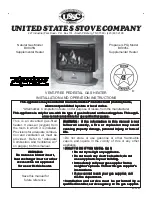
or fire lighters, and kindling on the
grate and cover with approximately 2
inches of fuel. Turn the control knob
to maximum, and open the airwash
control fully (see Fig. 1). Light the
paper or fire lighters. Close the doors
until the fuel is well ignited then load
with fuel and adjust the air controls to
the required setting.
On initial lighting, the stove may
smoke and give off an odour as the
silicon paint with which the firebox is
painted reacts to the heat. This is
normal and will cease after a short
time, but meanwhile the room should
be kept well ventilated.
When relighting the stove, riddle (if
burning solid fuel), remove any
clinker from the firebed and then
empty the ashpan.
The rate of burning and hence the
output is controlled by the control
knob on the side of the fire and the
airwash control (see Fig.1).
The control knob is linked to a
thermostat which senses the boiler
temperature. The number at the front
of the knob is the number at which it
is set.
The airwash control should be kept at
least slightly open most of the time to
keep the glass clean. It may be fully
opened when rapid heating is required
or to help clean any deposits from the
glass. It will not be possible to keep
the glass clean if this control is fully
closed, particularly immediately after
refuelling.
When burning solid fuels riddling
twice a day is usually sufficient. When
burning wood or peat, ash should be
allowed to build up and generally
weekly riddling will be sufficient. The
fire should be riddled with the doors
shut (see Fig 2.) Place the tool onto
the riddling lever and rotate between
the 1 o'clock and 3 o'clock positions
several times. Too much riddling can
result in emptying unburnt fuel into
the ashpan and should therefore be
avoided. If any clinker forms it should
be removed from the firebed. After
riddling, the grate should be put back
into the solid fuel or wood position as
required (the tool should be in the 1
o'clock position for solid fuel or in the
5 o'clock position for wood).
CONTROLLING THE
FIRE
RIDDLING
REFUELLING
ASH CLEARANCE
SPECIAL POINTS
WHEN BURNING
COAL
Keep the firebox well filled but do not
overfill to prevent fuel from spilling
over the top of the front fire bars.
Care should be taken especially when
burning wood that fuel does not
project over the front fire bars or
damage to the glass may be caused
when the doors are closed, it can also
cause the glass to black up.
The ashpans should be emptied
regularly before it becomes too full.
Never allow the ash to accumulate in
the ashpans so that it comes in contact
with the underside of the grate as this
will seriously damage the grate bars.
The ashpans are handled using the tool
provided. Care should be taken to
ensure that ash is cool before
emptying it into plastic liners or bins.
To make ash removal easier there is a
special
available. This may be purchased from
your supplier or, in case of difficulty,
from ourselves.
When loading the stove take care not
to smother the fire, instead fill the
firebox in two stages waiting between
Charnwood ash carrier
each stage for the flames to appear
above the fire.
After a period of slumbering always
turn the air control up to maximum
and wait until flames appear above the
fuel bed before opening the doors.
Burning coal will produce more soot
deposits than other fuels, especially if
the fire is run at low levels for long
periods. It is therefore vital to clean
the throat plate regularly, weekly
cleaning is recommended.
Never fully close the Airwash control
when burning coal.
The grate should be kept in the wood
burning position and should not be
riddled until the ash becomes so deep
that it begins to block the passage of
air into the firebox at the side of the
grate. When this is the case do not
remove all of the ash using the
riddling mechanism but keep a layer
about half an inch thick as this enables
the wood to burn more effectively.
When burning wood or peat use the
airwash control in the same way as
described (see "CONTROLLING
THE FIRE" )
For overnight burning the fire doors
must be closed.
When burning solid fuel the ashpans
should be emptied and the fire riddled.
If the fire is very low then it may be
necessary to add a little fuel and turn
the thermostat control up to maximum
for a brief period until the fire is
burning brightly before filling with
fuel. When the new fuel has ignited,
the thermostat control should be
turned down to the required setting
and the airwash control moved to a
low setting. If the central heating
pump is off overnight then the
thermostat may be left at the same
setting for both day and night
operation. If the central heating pump
is on overnight then set the thermostat
control to give the required level of
heating. Some experimentation will be
necessary to find the settings most
suitable for the particular fuel used
and the draw on the chimney.
To revive the fire, empty the ashpans,
riddle, and open the air controls to
SPECIAL POINTS
WHEN BURNING
WOOD AND PEAT
OVERNIGHT
BURNING
Fig 2. Grate Operation
Solid Fuel
Riddle
Wood
Page 2
Country 15B 09/03





























